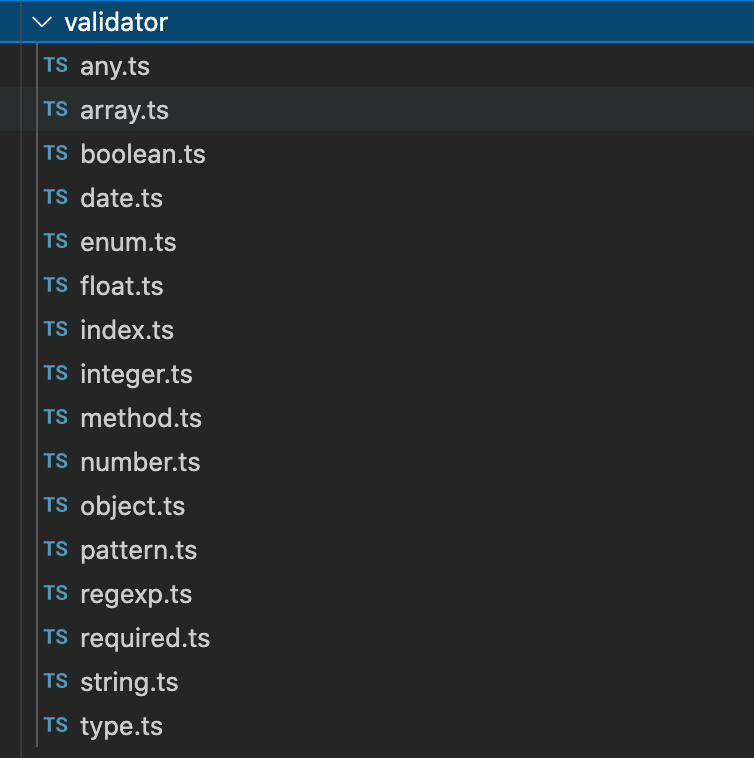平常开发写 element 表单的时候,肯定少不了表单的校验,element 使用的是 async-validator 这个开源库。

这篇文章详细分析一下 async-validator 的主流程。
使用方法
1 | import Schema from 'async-validator'; |
我们需要定义 descriptor ,也就是我们在 element 中定义的 rules ,然后创建一个 Schema 对象。
最后调用 validate 函数,传递三个参数:
第一个参数是要校验的对象
第二个参数是 options 对象, firstFields 为 true ,表示同一个字段如果有多个校验规则,一旦出现校验不通过的规则后边的规则就不执行了。
还可以设置 first 为 true,这个是针对整个校验对象的,如果某个字段校验不通过,那么后边所有的字段就不再校验了。
第三个参数是校验结束后的回调函数,erros 保存了所有校验失败的字段以及 message 信息。
因此,上边代码的输出如下:

list 对应结果的 message 是默认为我们添加的,limit 对应结果的 message 是我们自己设置的,会覆盖默认的 message。
因为我们设置了 firstFields 为 true ,所以只校验了 limit 的第一个规则,第二个规则就没有走到。
我们给 limit 设置一个值,让它走到第二个校验规则。
1 | validator.validate( |
输出如下:

此时 limit 对应结果就是一个 Error 对象了,Error 对象除了本身的 message 属性,默认还为我们添加了 field 和 filedValue 属性。
预处理 descriptor
校验前 async-validator 会将传入的 descriptor 规范化。
我们传进入的是下边的样子:
1 | const descriptor = { |
预处理后会变成下边的样子:
1 | { |
主要做了三件事情:
- 把每个字段的校验规则统一成了一个数组对象
- 把原本的校验对象放到了
rule属性中,并且添加了value、source、field属性 - 根据
required和type补充了默认的validator校验函数
预处理 descriptor 对应的源码
让我们过一下这部分源码。
在构造函数中,把 descriptor 所有字段的 rule 转为了数组,保存到 rules 对象中。
1 | constructor(descriptor: Rules) { |
剩下的处理都在 validate 函数中了,可以跟随下边的注释看一下:
1 | validate(source_: Values, o: any = {}, oc: any = () => {}): Promise<Values> { |
看下上边的 getValidationMethod 方法:
1 | getValidationMethod(rule: InternalRuleItem) { |
所有的校验函数都是提前定义好的:

在 前端的设计模式中-策略模式 中我们也提到过上边的逻辑。
循环校验
当我们有了预处理好的所有字段的校验规则。
1 | const series = { |
接下来只需要搞一个双重循环,执行所有的字段和每个字段的所有校验函数。
1 | for(const field of Object.keys(series)) { // 遍历每一个字段 |
rule 、data.value、data.source 就是当前规则相关的变量,options 是最开始调用校验的时候传进来的 { firstFields: true },,那么 cb 是什么?
cb 函数接受一个错误数据列表,如果返回的不是数组会包装为数组,然后对错误进行填充。
最后调用 doIt 函数,将校验结果传入,后边会介绍这个方法。
1 | function cb(e = []) { |
complementError 会返回一个函数,将错误列表进行填充,主要就是补充了 field 和 fieldValue 属性。
1 | export function complementError(rule: InternalRuleItem, source: Values) { |
收到的错误列表分为两种情况:
处理前如果 cb 收到的是 Error 列表,比如这样调用 cb(new Error('数量不能小于 100')); 。
那么处理前是下图:

处理后,就会往 Error 对象中塞入 field 和 fieldValue 属性。

处理前如果cb 是字符串列表,比如这样调用 cb(['list is required', 'list is not a number']) 。

同样的,处理后也是塞入 field 和 fieldValue 属性。

再回到我们的双重循环中。
1 | for(const field of Object.keys(series)) { // 遍历每一个字段 |
其中 validator 函数就是我们自己定义的:
1 | validator(r, v, cb) { |
由于 Element 官方示例是上边的样子,所以我们一般都按照上边的样子写,但其实我们也可以不调用 cb 函数,而是仅仅 return 字符串数组,或者 boolean 值,调用 cb 函数交给双重循环。
1 | validator(r, v, cb) { |
双重循环中来处理 validator 的返回值去调用 cb 函数。
1 | for(const field of Object.keys(series)) { // 遍历每一个字段 |
asyncMap
向上边我们直接粗暴的写双重循环去依次校验也没有问题,但因为校验库还支持一些参数,比如前边介绍的:

如果是 for 循环中去处理 firstFields 和 first 的逻辑,就过于耦合了,未来再扩充其他逻辑,双重循环中的逻辑就会越来越复杂。
async-validator 的处理方式在这里就比较优雅了,实现了 asyncMap 方法,作用就是遍历 series 数组,并且处理了 firstFields 和 first 参数的逻辑。
下边来分析一下实现:
看一下 asyncMap 的入口参数。
1 | export function asyncMap( |
接受 5 个参数:
objArr:要遍历的 rule 规则,就是我们前边生成的 series 数组,即双重循环遍历的对象。
option :最开始传入的 option,可能包含 firstFields 和 first 属性。
func:遍历过程的中会调用这个函数,会传入当前遍历的 rule 和一个 doIt 函数,doIt 函数需要接收处理好的校验结果。这里就需要我们之前 for 循环内部的处理逻辑。
callback : 全部检验结束后调用,会传入所有的校验结果。
source:要校验的对象。
这样我们就可以把 for 循环改为直接调用 asyncMap 函数了。
1 | asyncMap( |
第三个参数就是需要我们去处理 data 这个校验规则,也就是之前 for 循环中的逻辑移动过来。
其中 doIt 函数我们在之前讲的 cb 函数中调用即可。
1 | (data, doIt) => { |
最后就是全部遍历结束后的 complete 函数,我们只需要把 results 列表传到外边即可。
1 | function complete(results) { |
上边的 callback 函数就是我们调用校验函数时候外部传入的:
1 | const validator = new Schema(descriptor); |
内层循环
双重循环的的外层是遍历所有字段,内层是遍历该字段的所有规则。
我们来先看一下内层循环的实现:
async-validator 库提供了 asyncParallelArray 方法。
1 | function asyncParallelArray( |
接受三个参数:
arr 就是当前字段要遍历的规则列表。
func 是处理 rule 规则的函数,内部会调用这里的 count 方法,接受当前 a 的校验结果。
传入的 func 其实就是我们前边介绍过的 for 循环内部逻辑,a 是下边的 data 参数,count 就是下边的 doIt。
1 | (data, doIt) => { |
第三个参数 callback 是当前 arr 全部校验结束后的回调,代表当前字段的所有校验规则都判断结束。
这里需要注意的是,我们是通过 count 进入的次数来判断是否去调用 callback 函数,而不是 arr 遍历结束后调用 callback。
除了 asyncParallelArray 方法,因为有 firstFields 属性的存在,也就是遍历某个字段的所有规则时,如果出现校验不通过的规则就直接结束,后边的规则不再进行判断。
因此, async-validator 还提供了 asyncSerialArray 方法。
1 | function asyncSerialArray( |
入口参数和 asyncParallelArray 是一致的,区别在于对于 arr 是顺序执行,如果过程中出现了校验不通过的规则,就直接调用 callback 结束。
外层循环
外层循环和上边很类似,其实就是遍历所有字段,然后把每个字段的校验列表传给内层循环即可。
1 | export function asyncMap( |
入口参数前边已经介绍过了,可以看到我们做的就是遍历 objArrKeys 数组,然后根据 firstFields 的值去调用 asyncSerialArray 和 asyncParallelArray 。内存循环判断结束后会调用上边的 next 方法。
next 同样也是通过进入的次数,来判断是否调用 callback 函数,也就是前边介绍的 complete 方法。
和内层循环类似,因为有 first 属性的存在,也就是遍历某个字段时,存在校验不通过的字段就直接结束,后边的字段就不再进行判断。
我们只需要把所有规则打平,然后调用 asyncSerialArray 方法即可。
1 | if (option.first) { |
代码总
以上就是 async-validator 源码的主要流程了,说起来也简单,先预处理所有规则,然后通过 asyncMap 方法双层循环遍历所有校验规则即可,这个双层循环的抽离确实很优雅,避免了循环中耦合太多逻辑。
除了上边介绍的代码,因为 async-validator 还支持 Promise 的调用风格,校验函数支持 Promise 函数等其他功能,大家感兴趣也可以到 async-validator 看一下更详细的源码。
值得一提的点是,双层循环是通过计数来判断是否结束的,而进入计数其实就是调用 cb 函数。因此如果我们规则是下边的样子:
1 | import Schema from '../src/index'; |
因为我们没有传递 firstFields 属性,所以我们期望的是将 limit 所有的校验都进行了,limit 的值是 3 ,所以两个校验都没通过,应该输出下边的内容:

但其实只进行了第一个的校验:

原因就在于第一个 validator 进行了两次 cb ,然后内层循环的 callback 就提前调用了。
1 | validator(r, v, cb) { |
因此我们最好保证一个 validator 只进行一次 cb ,走到 cb 后就直接 return。(因为 Element 会设置 firstFields 为 true,所以其实有多个 cb 也不影响最终结果)
1 | validator(r, v, cb) { |
并且一定要有一个 cb ,不然最终的回调函数永远也不会执行了,这就是为什么 Element 提示我们要进行 cb 。

但这里说的也不够严谨,我们也可以返回字符串,或者字符串数组、布尔值等, async-validator 内部会根据 validator 返回的结果去调用 cb 函数。
1 | const res = rule.validator(rule, data.value, cb, data.source, options); |
async-validator 用计数的方式来判断是否去调用回调,就是为了实现异步的校验,当异步过程结束后才去调用 cb ,代表校验完成。
其他属性
平时写代码直接参照前人的校验规则去仿照着写了,大家也基本上是按照 Element 的样例来写校验规则,如果去 async-validator 看一下的话,会发现一些其他没听过的属性,这里也记录下。
validator 校验函数最多能接收到 5 个参数。
1 | validator(rule, value, callback, source, options) { |
我们可以通过第四个参数 source 拿到整个表单的对象,如果想校验一些联动的逻辑,我们就可以通过 source 拿到其他字段的值。
对对象字段的校验,如果校验字段是个对象,我们可以通过 fields 来校验对象中的字段。
1 | const descriptor = { |
transform 函数,可以将值先进行一次转换,然后再进行校验。
1 | const descriptor = { |
asyncValidator,校验函数内部是用 Promise 或者直接返回一个 Promise。
1 | const fields = { |
总
上边就是 async-validator 开源库的核心源码了,希望对你有帮助。
